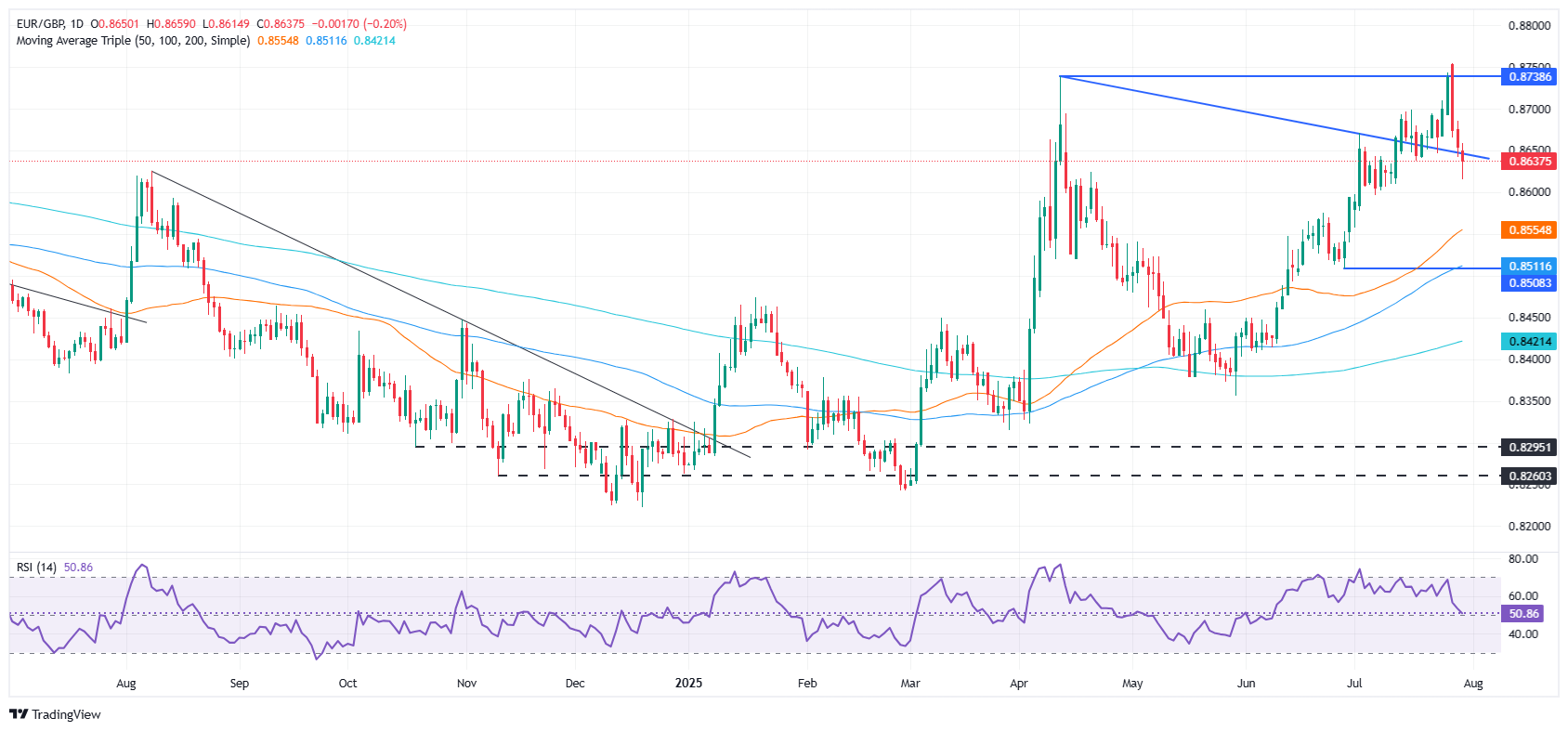EUR/GBP slips as US–EU trade deal lifts Dollar, BoE cut expected
- EUR/GBP drops over 0.15% as Euro weakens despite softer UK economic backdrop.
- Eurozone GDP slows to 1.4% YoY in Q2; Germany rebounds with 0.4% quarterly growth.
- BoE expected to cut rates next week, but sticky UK inflation keeps traders cautious.
The EUR/GBP extended its losses in the early North American session, down over 0.15% as traders digested trading news between the United States (US) and the European Union (EU). The shared currency has been pressured since the beginning of the week, even though the Bank of England (BoE) is expected to cut rates next week. The pair trades at 0.8636 after hitting a high of 0.8659.
Euro under pressure despite weak UK data, as upbeat US GDP and Fed focus weigh on cross ahead of BoE decision
Economic data in the US showed that the economy recovered and grew 3% according to Gross Domestic Product (GDP) figures for the second quarter of 2025. In the meantime, traders brace for the release of the Federal Reserve’s monetary policy decision, at around 18:00 GMT.
Economic data in the EU revealed that GDP for the bloc expanded by 1.4% YoY in Q2 2025, down from 1.5% expansion in the first quarter. GDP figures in Germany showed that the economy grew from 0% to 0.4% QoQ in Q2 2025.
Germany’s Retail Sales for June rose by 1% MoM, up from a -1.6% contraction in May, exceeding forecasts of 0.5% growth.
A scarce economic docket in the UK left traders leaning on last week's GDP print and Retail Sales data. The British economy seems to be struggling to grow, while sales missed estimates, growing less than expected.
Money markets had priced in close to 50 basis points of easing by the BoE toward the end of the year. However, inflation in the UK has proven to be stickier, and policymakers have grown divided about the economic outlook.
EUR/GBP Price Forecast: Technical outlook
The EUR/GBP has fallen below the 20-day Simple Moving Average (SMA) of 0.8657, after reaching a yearly peak of 0.8756 on July 28. The Relative Strength Index (RSI) fell toward its neutral line, an indication that sellers are gathering momentum. However, they need to clear the July 30 low of 0.8614 to test 0.8600, aiming to reach the 50-day SMA at 0.8564.
Conversely, if EUR/GBP rises past the 20-day SMA, buyers could target the 0.8700 figure. IF surpassed, the next area of interest would be the YTD high of 0.8756.

Euro FAQs
The Euro is the currency for the 19 European Union countries that belong to the Eurozone. It is the second most heavily traded currency in the world behind the US Dollar. In 2022, it accounted for 31% of all foreign exchange transactions, with an average daily turnover of over $2.2 trillion a day. EUR/USD is the most heavily traded currency pair in the world, accounting for an estimated 30% off all transactions, followed by EUR/JPY (4%), EUR/GBP (3%) and EUR/AUD (2%).
The European Central Bank (ECB) in Frankfurt, Germany, is the reserve bank for the Eurozone. The ECB sets interest rates and manages monetary policy. The ECB’s primary mandate is to maintain price stability, which means either controlling inflation or stimulating growth. Its primary tool is the raising or lowering of interest rates. Relatively high interest rates – or the expectation of higher rates – will usually benefit the Euro and vice versa. The ECB Governing Council makes monetary policy decisions at meetings held eight times a year. Decisions are made by heads of the Eurozone national banks and six permanent members, including the President of the ECB, Christine Lagarde.
Eurozone inflation data, measured by the Harmonized Index of Consumer Prices (HICP), is an important econometric for the Euro. If inflation rises more than expected, especially if above the ECB’s 2% target, it obliges the ECB to raise interest rates to bring it back under control. Relatively high interest rates compared to its counterparts will usually benefit the Euro, as it makes the region more attractive as a place for global investors to park their money.
Data releases gauge the health of the economy and can impact on the Euro. Indicators such as GDP, Manufacturing and Services PMIs, employment, and consumer sentiment surveys can all influence the direction of the single currency. A strong economy is good for the Euro. Not only does it attract more foreign investment but it may encourage the ECB to put up interest rates, which will directly strengthen the Euro. Otherwise, if economic data is weak, the Euro is likely to fall. Economic data for the four largest economies in the euro area (Germany, France, Italy and Spain) are especially significant, as they account for 75% of the Eurozone’s economy.
Another significant data release for the Euro is the Trade Balance. This indicator measures the difference between what a country earns from its exports and what it spends on imports over a given period. If a country produces highly sought after exports then its currency will gain in value purely from the extra demand created from foreign buyers seeking to purchase these goods. Therefore, a positive net Trade Balance strengthens a currency and vice versa for a negative balance.

